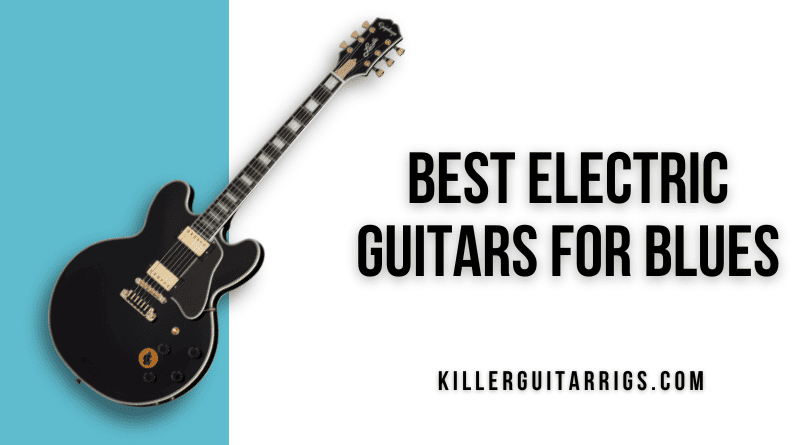Electric guitars for blues are as varied as they can possibly be. There are plenty of models that are good choices for playing blues. From solid bodies to semi-hollow body instruments, master blues players have employed quite a few guitar models, often in the same concert.
Naturally, specific features like tonewoods and pickups also come into play and add up to seemingly endless features. Regardless of these, blues players typically go for instruments that are highly expressive. A big part of which type of blues guitar is right for you comes down to taste and preferences, and you may even like a few different instruments to play blues.
Manufacturers know that different players require different instruments, and are prepared to meet the demand. As a result, there are plenty of guitars that are good for playing blues, and it all depends on the player’s preference.
With so many options out there, how do you make sense of it all? In this article, we help you sort through the best options available today. Keep reading.
Read more about our review process.
Our Top 3
The Epiphone B.B. King Lucille Semi-Hollowbody is our Top Choice and comes with a 5-ply layered maple body. With this guitar, you get an affordable version of the legendary bluesman’s beloved instrument, with fantastic response and versatile sound.
The Squier Classic Vibe ’70s Stratocaster HSS is our Budget Choice and features a lightweight poplar body and versatile pickup configuration. With Fender-designed single-coil Alnico pickups and a humbucker, you get the best of both sonic worlds.
The Gibson Les Paul Studio is our Editor’s Choice. This guitar is a great option for dedicated professionals and features a weight-relieved Mahogany body and a pair of coil-tapped humbuckers for superior sound and overall traits.
Individual Reviews
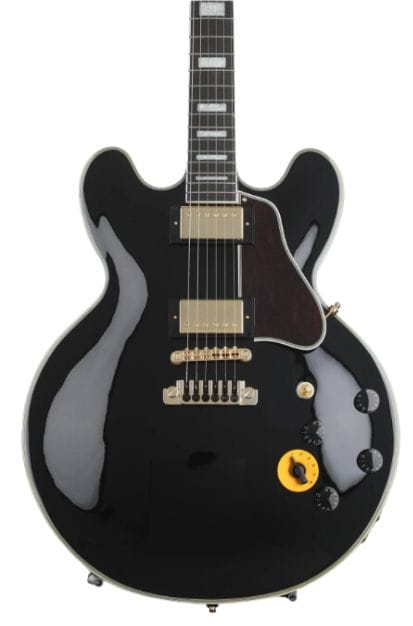
Epiphone B.B. King Lucille Semi-Hollowbody
A tribute to the ultimate blues master.
This guitar pays homage to one of the greatest blues legends to ever live: the King of The Blues, Mr. B.B. King. This beautiful instrument is a semi-hollow body based on Mr. King's iconic and beloved “Lucille” guitar which he played for decades.
The Epiphone B.B. King Lucille Semi-Hollowbody comes with a 5-ply layered maple body and offers the player the chance to play an affordable version of the legendary bluesman’s instrument.
The first thing we loved about this instrument is how beautiful it is, with its black color and gloss body finish. We started our tests by trying this guitar unplugged. We loved the feel and response of the maple neck with an ebony fingerboard and got a nice projection while playing it acoustically.
We really liked how this instrument responded to big band comping style, with the use of some shell voicings. Although there are no F-holes on the top, this guitar delivers nice resonance unplugged and presents a viable way to practice when no amp is available.
We then plugged into our Fender Twin Reverb amp to check out how it sounded with some effects and solo. This guitar comes with two Alnico Classic Pro humbuckers. We started with the neck pickup on clean, and got a beefy, hum-free tone that was fantastic for both blues and jazz.
We really liked to play around with the 6-position Varitone switch which gave us plenty of sonic options. This Varitone switch was found on the original ES-355s from the late ’50s but was later discontinued. We used it to filter and scoop our mid frequencies with each position, and also to dial in some vintage rock and blues tones.
The neck pickup features Alnico V (just like the bridge pickup) and sounded fantastic with a bit of overdrive. We got nice sustain and even attempted some of those minimalistic but very tasteful B.B. King licks.
Verdict: The Epiphone B.B. King Lucille Semi-Hollowbody pays homage to B.B. King by imitating his main instrument. It comes with a 5-ply layered maple body, fantastic playability, and tone and offers an affordable version of the legendary bluesman’s instrument. In short, this was a great guitar that pays homage to the original Lucille that accompanied B.B. King for a good portion of his career.

Squier Classic Vibe '70s Stratocaster HSS
The ultimate budget Strat.
The Strat is a verified blues machine and has been the main instrument for legends such as Stevie Ray Vaughan, Robert Cray, and Eric Clapton. The Classic Vibe 70's Stratocaster delivers all that blues power at a truly affordable price and comes with a very versatile HSS pickup configuration, so you can have both single coil and humbucker tones in one instrument.
The Squier Classic Vibe ’70s Stratocaster HSS comes with a lightweight poplar body and features a versatile pickup configuration that gives the user the best humbucker and single coil sounds.
We plugged into our Fender Twin Reverb to try out this Squier. We began by auditioning the Fender-designed single-coil Alnico pickups on both the neck and middle positions. For the neck, we got a rounder tone that can be great for some darker blues sounds, for both leads and rhythm.
The middle pickup gave us that particular twang that we all love about Strats, and we really liked position four, with both the middle and neck pickups active. We also liked the middle position with a bit of overdrive via our Tube Screamer.
The Fender Alnico Humbucker pickup in the bridge gave us greater punch and girth than we’d normally get with a single coil. It sounded good with both distortion and overdrive, and we liked the sustain it had, great for blues solos and licks. In true Strat fashion, this Squiere comes with a five-position blade, two tone controls, and one volume knob.
Regarding playability, this Squier comes with a “C”-shaped neck on a maple fingerboard. We loved how it felt and how it responded as well, with a 9.5″ radius and your typical 25.5″ Fender scale length. In essence, a very familiar feel that has been employed by blues players for decades.
Verdict: The Squier Classic Vibe ’70s Stratocaster HSS offers great versatility for blues players with humbucker and single coil sounds. It features a true Fender feel, with a snappy maple neck and fretboard, and other authentic appointments blues guitarists have used for over half a century.
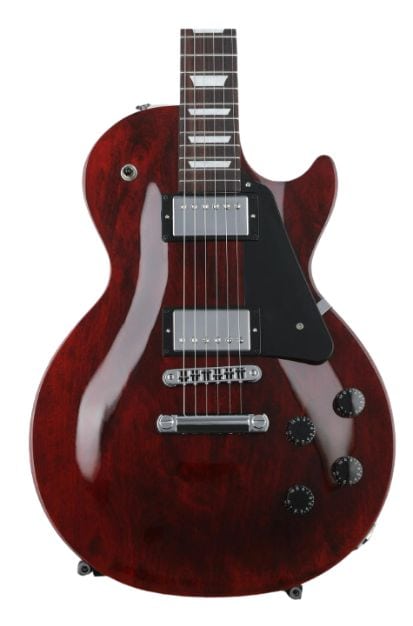
Gibson Les Paul Studio
Superior tone and expression.
From Jeff Beck to Joe Bonamassa, the Gibson Les Paul is a verified blues machine. This guitar offers the tone and expression that many blues players seek and is one of the top choices among discerning professionals that are willing to pay for the best. With superior tone and playability, this Les Paul delivers.
The Gibson Les Paul Studio features a weight-relieved Mahogany body and comes in a beautiful Wine Red color on a gloss nitrocellulose lacquer finish.
We were excited to try out this Les Paul and used our Fender Twin Reverb amp for our tests. This guitar comes with a pair of coil-tapped humbuckers, with a 490R on the neck position and a 498T on the bridge position.
We started with the bridge humbucker with a bit of overdrive from our Tube Screamer. We got a great forward tone with nice sustain, perfect for lead and rhythm parts with attitude. With higher distortion dialed in, we got a powerful and balanced tone, great for blues and beyond.
Moving on to the neck humbucker, we got a warm and sweet tone when played on clean. We liked this pickup for a variety of rhythm styles, including chord solos on jazz standards. With some distortion added, we got a killer tone on power chords and licks, with a darker but very articulate tone and great string separation.
One of our favorite features on the Gibson Les Paul Studio is the weight-relieved mahogany body. One of the main cons that Les Pauls have is their weight, but here you get the renowned sustain and tone without having to injure your back while on long gigs.
We also loved that there is no binding on this instrument, which makes for a super smooth feel.
We loved how this guitar felt in our hands. The SlimTaper neck profile is comfortable and reminded us of the ’60s Gibson instruments. The Rosewood fingerboard and classic 24.75″ scale length also felt great, and along with a 12″ radius give this instrument great playability.
Verdict: The Gibson Les Paul Studio gives you that great tone and sustain that these guitars are known for but without the massive weight. With a weight-relieved Mahogany body, and a 60s feel on the neck, this guitar is a fantastic choice for professionals that play a variety of styles, including blues.
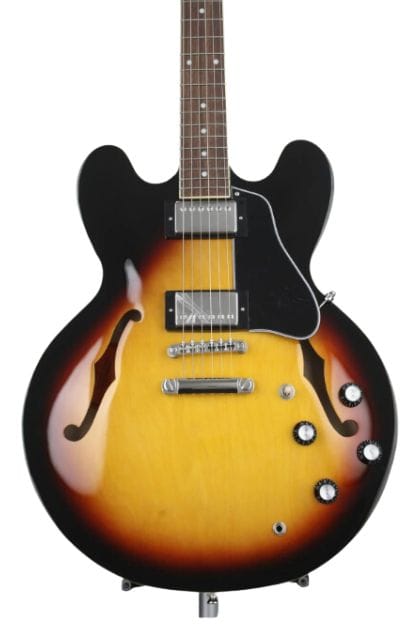
Epiphone ES-335 Semi-hollowbody
Powerful tone with sustain for days.
The "335" as it is commonly known, is a versatile guitar that excels in a variety of styles. This 335 gives you a vibrant and powerful tone provided thanks to its semi-hollow body, and is widely regarded as an expressive blues guitar. Epiphone brings us an affordable version of this celebrated guitar.
The Epiphone ES-335 Semi-Hollowbody comes with a maple top, back, and sides, in a classic vintage sunburst color. And just like the original 335 by Gibson, this Epiphone features a solid maple center block for improved tone and sustain.
The first thing we loved about this guitar was how it felt in our hands. With a mahogany neck and Epiphone’s rounded “C” profile, this 335 features a responsive Indian laurel fingerboard that feels fantastic. With a 12-inch radius, a typical Gibson scale length of 24.724″, and a
nut width of 1.693″, this Epiphone delivers nice playability for expressive blues playing.
Plugged in, this guitar sounds as good as it feels. With Alnico Classic PRO humbuckers on the bridge and neck position, this Epiphone 335 is as versatile as they come. We got some sweet and darker clean tones from the neck pickup on clean, great for playing jazz as well as rhythm work in other styles. With a bit of overdrive, we got a nice round tone for soloing in a variety of blues styles.
On the other hand, the neck pickup gave us several vintage tones with a nice humbucker flavor. In clean, we got that unmistakable rockabilly timbre that can be used in several styles, and with overdrive and distortion, a punchy growl. We particularly liked this pickup with overdrive via our Tube Screamer, perfect for penetrating blues lines that are never too shrill sounding.
Verdict: The Epiphone ES-335 Semi-Hollowbody comes with a maple top, back, and sides and features a solid maple center block for improved tone and sustain. It gives you a tonal combination that goes from warm to penetrating thanks to both of its humbuckers.
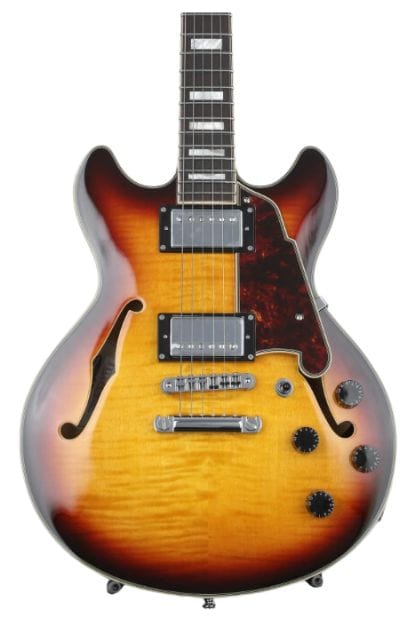
D'Angelico Premier Mini DC XT Electric Guitar
A good hollow-body guitar, with great playability.
D'Angelico has become one of the best choices for guitarists that require great quality at a reasonable price. With a good level of craftsmanship and great overall features, this guitar does a great job for blues as well as another variety of styles.
The D’Angelico Premier Mini DC XT features a reduced-size laminated maple body and comes in a nice vintage sunburst color. The first thing we loved about it is how resonant it is even when unplugged, a great trait for any semi-hollow guitar.
We also liked the C profile on its maple neck, with a responsive Ovangkol fingerboard. The 14-inch-radius allowed for a nice grip and we enjoyed the comfort that the shorter 25-inch scale length provides. With the Premier Mini DC, we were able really to dig in with bends while it remained nicely tuned and very stable thanks to its locking tuners, another fantastic feature on this guitar.
Besides nice playability, this instrument also sounds great plugged in. It comes with a Seymour Duncan SH-2n Jazz Humbucker pickup on the neck position. Here we got a warm and full-bodied humbucking tone with great clarity, perfect for jazz and blues.
On the other hand, the bridge pickup features a Seymour Duncan SH-4 JB Humbucker and sounded great in clean, overdrive and distorted, with plenty of punch and no noise. This is completed with a 3-way toggle switch and two volume and tone controls, as expected in this type of design.
Verdict: The D’Angelico Premier Mini DC XT comes in a reduced-size laminated maple body that is comfortable and provides great versatility for blues and beyond. With a set of Seymour Duncan humbuckers, this guitar sounds and plays as well as it looks. We thought this was a great guitar for blues, with nice playability, versatility and tones, and with D’Angelico’s signature stylish headstock.
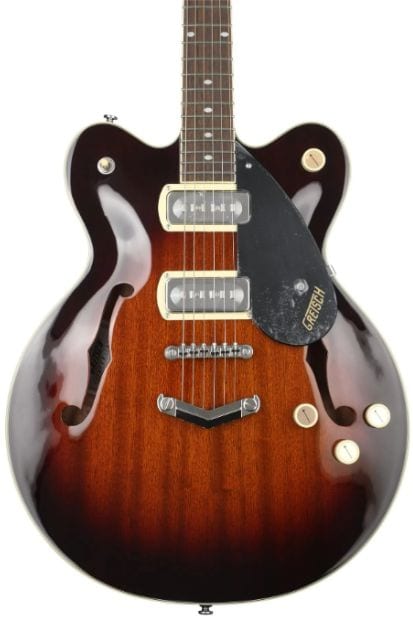
Gretsch G2622-P90 Streamliner
Retro vibe with unique P-90 tone.
Gretsch is one of the most traditional music brands in history, and their guitars have been used by plenty of legends. The G2622-P90 is a great choice for beginners interested in blues and comes at an affordable price, as it comes with a fat tone and authentic Gretsch feel and playability.
The Gretsch G2622-P90 Streamliner features the usual center block found on semi-hollow body electric guitars, as it helps keep feedback at bay. With a mahogany body and a pair of FideliSonic 90 pickups, this guitar was made to provide a unique tone.
We plugged into our Fender Twin Reverb and started our tests with the neck pickup. Here we got a vintage P-90 tone that was great for blues and jazz, and that offered clarity even with some overdrive added.
Although we liked the particular sound of the neck pickup, we felt that the Gretsch G2622-P90 sounds better with the bridge pickup. The neck pickup gave us a more forward and bitey tone that can fit well for styles like blues and rockabilly. This pickup also did well with a bit of overdrive and even distortion.
Regarding playability, this guitar felt relatively comfortable with its U-shaped nato neck on a laurel fingerboard. These are good features for beginners that don’t yet have a preference for specific tonewoods but want a good instrument to start on.
Verdict: The Gretsch G2622-P90 Streamliner is a good guitar for beginners that are attracted to semi-hollow body instruments. It comes with the usual center block found for curbing feedback and features a pair of FideliSonic 90 pickups. It offers a vintage look and feel and comes complete with a pair of styles F holes. Ultimately, we think this is a good guitar for anybody just getting started and who wants something a little different.
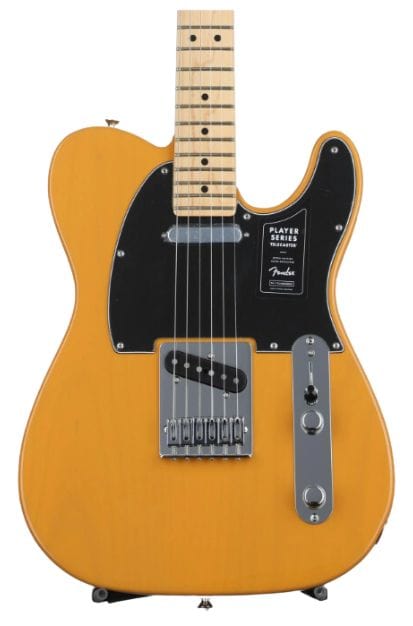
Fender Player Telecaster
Tele feel and tone for modern blues players.
This guitar is excellent for folks that value an authentic Tele feel and the versatility this instrument provides. With a beautiful Butterscotch Blonde that is one of the most traditional choices for Telecasters, this guitar delivers in tone, playability and looks.
The Fender Player Telecaster comes with the proven and beloved two-single coil Tele design to deliver twang and attitude for blues, country, rock, and more. All of this comes with Tele playability and feel, and this guitar is nothing short of a classic.
We plugged into our Twin Reverb amp for our tests, with our Ibanez Tube Screamer on the chain. We dialed some overdrive and got a forward and twangy tone on the bridge pickup, a Player Series Alnico V Tele Single-coil. This pickup delivered that signature Tele sound, perfect for so many styles, including blues.
We then moved to the neck pickup, also a Player Series Alnico V Tele Single-coil. We liked how it sounded both clean and overdriven, with its darker yet still forward character.
Regarding playability, this instrument is purely Fender. We got a kick out of the comfortable Modern C maple neck and liked the feel of the 9.5″ radius As expected, we got a typical Tele scale length of 25.5,” which made us feel right at home. Naturally, some pricier Teles offer more premium features, but all and all this is a good buy for the money.
Verdict: The Fender Player Telecaster comes with that signature twang and tone, ideal for blues, country, rock, and more. With authentic Tele playability and feel, this is a good guitar for beginners to intermediate players.
How To Choose The Right Guitar For You
Guitars for blues can be quite varied, as blues players can have vastly different preferences and overall needs. Below we share some of the most common guitar types for blues players, as well as some things to look for when choosing your ideal guitar.
Semi-hollow body
Semi-hollow guitars like the 335 or similar are preferred by many blues players. Legends like B.B. King, Freddie King, Alvin Lee and Robben Ford are renowned for making these guitars sing. These guitars tend to offer a deeper and more resonant sound thanks to the acoustic cavity inside them.
They are also very versatile and not as prone to feedback as hollow-body guitars like the ES-175. This is in great part thanks to their design which features a center block to eradicate feedback. This allows the user not only to turn up without fear but also to use effects like overdrive and distortion without unwanted noises.
Besides being very expressive instruments for blues, semi-hollow guitars can also be used in jazz, rock, and more. These are very versatile instruments that can work in a variety of styles, with blues being one where they excel at.
Solid-body
Solid-body guitars are the most popular and the best sold. They tend to be more affordable than semi-hollow guitars and offer great versatility as well.
The Stratocaster and Telecaster (and their many copies) are two of the most popular for blues players. They offer that single coil twang that many players love and that works great for cutting through, especially during your solos. You also have the choice of getting any of these two with a humbucker or more in the mix, for greater versatility.
Popular Stratocaster blues players include Stevie Ray Vaughn and Eric Johnson. On the other hand, renowned blues players that preferred the Tecaster include legend Muddy Waters. Although technically not a blues legend, Keith Richards is a legend of his own, playing mostly blues licks on the Rolling Stones.
However, if you want a more traditional humbucker tone on a solid body, the Les Paul is among the most popular choices. With a greater output than most single coil guitars, Les Pauls also offers a unique playing experience.
Naturally, the best would be to have a variety of these instruments so you can pick whichever you want for any given night, a la Joe Bonamassa. After all, all of these guitars offer different flavors and peculiarities that may resonate with you more at different moments.
Tonewoods
Another important aspect to consider when choosing your guitar for blues is which woods are used. These will have an impact on your tone and sustain when it comes to the body, and feel and responsiveness when it comes to the neck and fingerboard.
For instance, Alder is a popular choice for guitar bodies, particularly Strats and Teles. It is a popular tonewood because it has a balanced tone while remaining relatively light.
Ash is also a popular tonewood, known for providing a balanced tone while remaining affordable. It also produces a pleasant upper-midrange, with a clear bass.
For necks and fretboards, one of the most popular choices is mahogany. It offers a nice response and is sometimes also used on a guitar’s body.
The other very popular choice for necks and fretboards is maple. This tonewood is known for offering a snappy response and great overall quality.
Although there are plenty of other tonewoods for body and necks, the ones above are the most popular. Not only do they offer great quality, but are also cost-effective. More exclusive options like Bubinga can dramatically increase the price of your instrument.
Final Thoughts
A blues guitar, just like any other instrument, is a highly personal choice. The best is to play different types of guitars and develop a taste for what you like and what resonates with you. After all, different guitarists connect with different guitars.
Nowadays, you also get to individually pick different features of a particular guitar model. For instance, you can have a Strat with a humbucker, as well as not-so-common wood choices. The key is to develop your own criteria in order to know what you like and what you don’t.
To recap our choices, the Epiphone B.B. King Lucille Semi-Hollowbody is our Top Choice. With a maple body and a typical 335 design and tone, this is a more affordable version of B.B. King’s beloved guitar.
The Squier Classic Vibe ’70s Stratocaster HSS is our Budget Choice and features a versatile pickup configuration on a lightweight poplar body. With Fender-designed Alnico pickups and a humbucker, you get an HSS configuration for maximum versatility.
Last but certainly not least, the Gibson Les Paul Studio is our Editor’s Choice. A fantastic option for devoted professionals and you get fat Les Paul tone on a lighter version, thanks to its weight-relieved Mahogany body.

